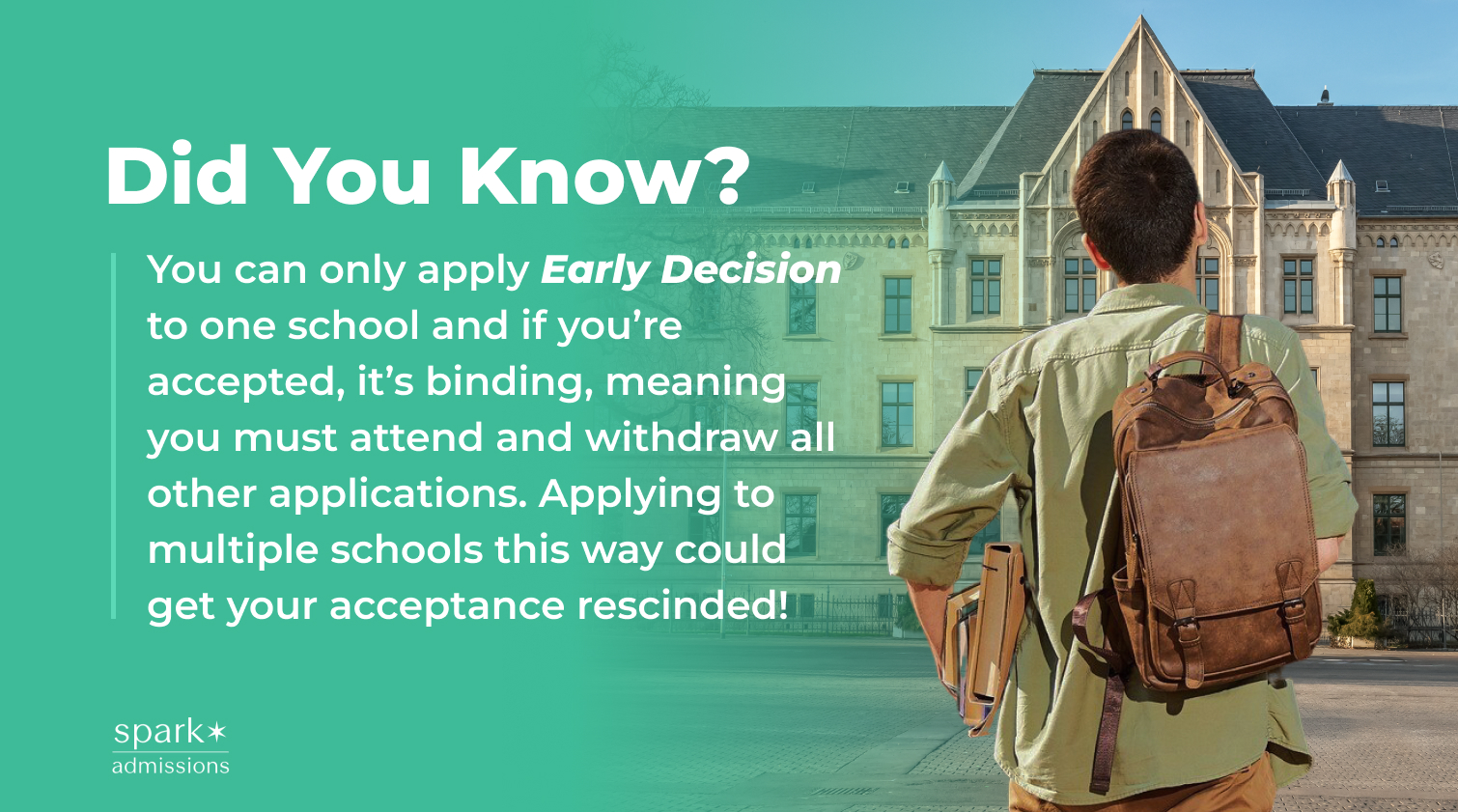- Blog
- > Early Decision
Can You Apply Early Decision to Multiple Schools?
- Dr. Rachel Rubin
- | July 23, 2025

With college admissions becoming increasingly competitive, especially at Top 50 colleges, students and families are looking for every possible edge. For many, this means applying early through Early Decision or Early Action programs. But a key question arises every application cycle: Can you apply Early Decision to multiple schools?
The answer is simple: No, you cannot apply Early Decision to more than one school at a time. That’s because Early Decision is a binding commitment, unlike Early Action applications, which are non-binding. However, there’s a great deal of nuance in how these programs work, including Restrictive Early Action and Early Decision II offerings, and it’s also important to consider the impact of applying early on financial aid and admissions outcomes.
This article will walk you through everything you need to know about Early Decision deadlines, early application strategies, and how to maximize your chances of acceptance while staying in line with application rules.

Understanding the Basics of Early Decision
Early Decision is a college admissions program that allows students to apply to one school early, typically by November 1. In return, applicants receive an admission decision in mid-December, months before the Regular Decision cycle.
However, applying Early Decision means signing a binding agreement. If accepted, the student agrees to enroll at the school in question and to withdraw all applications from other schools. This binding nature means you are committing to attend that institution, regardless of other offers or financial aid packages.
What Happens If You Break the Rules?
If a student applies Early Decision to multiple colleges, they are violating the terms of the Early Decision agreement—an agreement signed by the student, their parent or guardian, and their school counselor.
Colleges take this agreement seriously. Admissions officers communicate with each other, and if they discover a student submitted multiple Early Decision applications, they may rescind admission offers or notify other institutions. Such responses would damage the student’s credibility and could eliminate their chances of attending other schools altogether.

How Is Early Action Different from Early Decision?
Early Action programs also allow students to submit their applications by an earlier date, often around November 1 or 15, and receive a response by December or January. However, unlike Early Decision, Early Action is non-binding.
Students accepted through Early Action are not required to enroll and may compare offers from multiple colleges before making a final decision by May 1.
This makes Early Action a more flexible option for students who want the benefit of applying to college early without making a commitment. While you cannot apply Early Decision to more than one school, you can apply Early Action to as many schools as you like, with some exceptions.
Related Article: Early Action vs. Early Decision Differences and Benefits
Understanding Restrictive and Single-Choice Early Action Policies
Some highly selective private universities offer Restrictive Early Action or Single-Choice Early Action. These are still non-binding programs, but they limit where else you can apply early during the admissions process.
For example, the admissions office at schools like Harvard, Yale, and Princeton may prohibit applicants from submitting Early Action or Early Decision applications to another private college. However, you can still apply to public universities or submit Regular Decision applications elsewhere.
It’s important to read each college’s policy carefully. While Restrictive Early Action is not a binding commitment, it still limits how many schools you can apply to early.
Can You Apply Regular Decision While Applying Early Decision?
Yes, you can submit Regular Decision applications to many colleges even if you’ve applied to one school Early Decision. But if you are accepted to your ED school, you are required to withdraw those other applications immediately.
This is why it’s important to be absolutely sure when selecting your Early Decision school. It should be the dream school you most want to attend, where you would be excited to enroll, regardless of what other colleges may offer later.
What Is Early Decision II?
Some colleges offer a second round of Early Decision, called Early Decision II, with deadlines a few weeks later, typically in early January. Early Decision II follows the same binding rules as the first round.
This option is ideal for students who were not ready to commit in the fall or who were deferred or rejected in the first round of Early Decision. Students can apply Early Decision II to only one school, and if accepted, they are required to attend.
While you cannot apply Early Decision to multiple schools at once, ED II gives students another opportunity to demonstrate commitment to a top-choice school, just later in senior year.

Benefits of Applying Early Decision
Many students wonder whether applying early increases their odds of admission. While not guaranteed, students often see higher acceptance rates in Early Decision programs than in Regular Decision.
That’s because admissions offices view Early Decision applicants as highly committed, enthusiastic candidates for their institution. Accepting these students also helps colleges manage yield (the percentage of accepted applicants who enroll), which is a key factor in college rankings.
Applying early also means students may receive decisions months before Regular Decision deadlines, reducing stress in the second half of senior year.
However, students must understand that financial aid offers are typically not negotiable in the Early Decision process. If your family is relying heavily on financial aid, it may be better to apply Early Action or wait until Regular Decision so you can compare financial aid packages across several schools.
Early Action Is a Strategic Advantage for Many Students
Early Action applicants also benefit from applying earlier and receiving decisions sooner. Unlike Early Decision, these programs allow students to:
- Keep their options open
- Apply to multiple colleges at once
- Compare financial aid offers before committing
This flexibility is especially helpful for students applying to public colleges and universities that offer Early Action deadlines but do not require a binding commitment.
When to Choose Regular Decision
If you are not ready to commit, or if your academic profile may improve later in senior year, Regular Decision might be the right path. Regular Decision gives students more time to raise their GPA, retake standardized tests, or build a stronger application narrative by the regular deadline.
Additionally, Regular Decision applicants have the opportunity to compare all acceptances and aid packages before making a final choice. While you may not benefit from the admissions boost associated with applying early, you will retain full control over your college selection process.
Building a Balanced Application Strategy
Since you can’t apply Early Decision to more than one school, it’s wise to build a balanced application list that includes:
- One Early Decision school (if applicable)
- Several Early Action schools (as permitted)
- A mix of Regular Decision options
This approach allows you to show demonstrated interest, potentially receive early admissions results, and keep your options open as you await decisions from other colleges.
Select Your Top-Choice College for the Early Decision Deadline
Choosing between Early Decision, Early Action, and Regular Decision depends on your goals, financial needs, and where you are in the college admissions journey. If you’re unsure how to apply early, when to submit applications, or whether your dream school should be an Early Decision school, Spark Admissions can help.
Our expert admissions consultants will analyze your academic profile, help you choose the right mix of early and regular applications, and guide you through deadlines, essays, and interview prep. With our help, you can maximize your admissions and financial aid outcomes.
Contact us today to build a strategy that works, on your terms, with your goals in mind.


